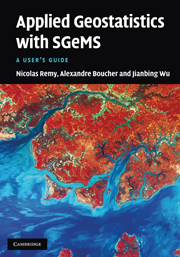Book contents
- Frontmatter
- Contents
- Foreword by Albert Tarantola
- Preface
- List of programs
- List of symbols
- 1 Introduction
- 2 General overview
- 3 Geostatistics: a recall of concepts
- 4 Data sets and SGeMS EDA tools
- 5 Variogram computation and modeling
- 6 Common parameter input interfaces
- 7 Estimation algorithms
- 8 Stochastic simulation algorithms
- 9 Utilities
- 10 Scripting, commands and plug-ins
- Bibliography
- Index
3 - Geostatistics: a recall of concepts
Published online by Cambridge University Press: 05 November 2011
- Frontmatter
- Contents
- Foreword by Albert Tarantola
- Preface
- List of programs
- List of symbols
- 1 Introduction
- 2 General overview
- 3 Geostatistics: a recall of concepts
- 4 Data sets and SGeMS EDA tools
- 5 Variogram computation and modeling
- 6 Common parameter input interfaces
- 7 Estimation algorithms
- 8 Stochastic simulation algorithms
- 9 Utilities
- 10 Scripting, commands and plug-ins
- Bibliography
- Index
Summary
This user's manual is no place for another presentation of the theory of geostatistics. Many excellent books and reference papers are available to such purpose: Journel and Huijbregts (1978); Isaaks and Srivastava (1989); Cressie (1993); Wackernagel (1995); Goovaerts (1997); Deutsch and Journel (1998); Chilès and Delfiner (1999); Olea (1999); Lantuéjoul (2002); Mallet (2002). In this chapter we will only review the basic concepts and geostatistical principles underlying the algorithms offered in SGeMS. The more recent developments of multiple-point geostatistics are presented in relatively greater length because they are less known. Engineering-type presentations are preferred over more rigorous but less intuitive developments. These presentations point to programs coded into SGeMS whenever available.
A warning about references. We have limited citations to a few most relevant and easily accessible references. We give page numbers only to the three books by Goovaerts (1997), Deutsch and Journel (1998) and Chilès and Delfiner (1999). For an extensive list of references the reader may turn to the list proposed by Cressie (1993) and that of Chilés and Delfiner (1999).
Section 3.1 introduces the concept of random variable to model the uncertainty about a single variable. That concept is extended in Section 3.2 to a random function modeling the joint uncertainty about several interdependent variables distributed in space. The various possible outcomes of a random variable or random function are controlled by probability distribution functions made conditional to the data available; simulated outcomes can then be drawn from these conditional distributions, as discussed in Section 3.3.
- Type
- Chapter
- Information
- Applied Geostatistics with SGeMSA User's Guide, pp. 29 - 79Publisher: Cambridge University PressPrint publication year: 2009

